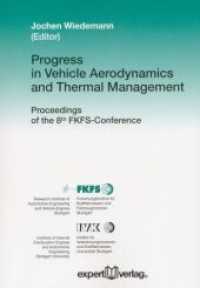- ホーム
- > 洋書
- > ドイツ書
- > Mathematics, Sciences & Technology
- > Biology
- > Ecology
Full Description
Cave organisms are the 'monsters' of the underground world and studying them invariably raises interesting questions about the ways evolution has equipped them to survive in permanent darkness and low-energy environments. Undertaking ecological studies in caves and other subterranean habitats is not only challenging because they are difficult to access, but also because the domain is so different from what we know from the surface, with no plants at the base of food chains and with a nearly constant microclimate year-round.
The research presented here answers key questions such as how a constant environment can produce the enormous biodiversity seen below ground, what adaptations and peculiarities allow subterranean organisms to thrive, and how they are affected by the constraints of their environment. This book is divided into six main parts, which address: the habitats of cave animals; their complex diversity; the environmental factors that support that diversity; individual case studies of cave ecosystems; and of the conservation challenges they face; all of which culminate in proposals for future research directions. Given its breadth of coverage, it offers an essential reference guide for graduate students and established researchers alike.
Contents
Preamble.- Part I. Into Karst, Caves and Cave Habitats.- Physiography of the Caves.- Where Cave Animals Live.- Part II. There is Rich and Diverse Life in Cave.- The Ecological Classification of Cave Animals and their Adaptations.- The Microbial Diversity of Caves.- Phototrophs in Caves.- Diversity of Cave Terrestrial Inhabitants.- Short Overview on the Aquatic Cave Fauna.- Subterranean Biodiversity Patterns from Global to Regional Scales.- Historical and Ecological Factors Determining Cave Diversity.- Part III. About Communities, Populations and Food.- Cave Communities and Species Interactions.- Structure and Genetics of Cave Populations.- Caves as Oligotrophic Ecosystems.- Food Webs in Caves.- Part IV. Particular Cave Ecosystems.- Ice Caves.- Researches in Sulphide Based Ecosystems.- Researches in Lava Tubes.- Research in Anchialine Caves.- Volcanic Anchialine Habitats of Lanzarote.- Research in Calcretes and Other Deep Subterranean Habitats Outside Caves.-Subterranean Biodiversity in Ferruginous Landscapes.- Part V. Conservation and Protection of Cave Habitats and Cave Fauna.- Conservation of Cave Fauna, with an Emphasis on Europe and the Americas.- Conservation and Impact Assessment of Subterranean Fauna in Australia.- Part VI. Cave Ecology for the 21ST Century.- Where Angels Fear to Tread: Developments in Cave Ecology.








